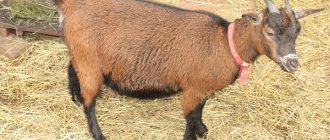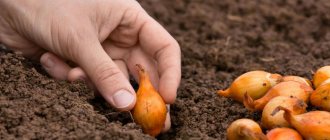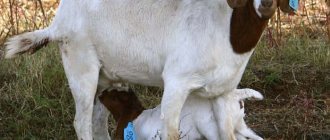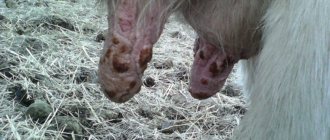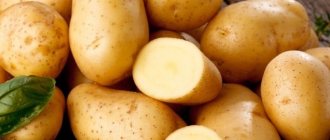Causes
Let's figure out why a goat loses its milk; some factors influence the volume of milk yield:
- Animal breed.
- Udder shape.
- Features of the body of each individual.
- Age.
Farmers are unable to influence these factors. An individual gives 2-3 liters of health per day, and specially bred species - 4-5 liters. A rare Swiss breed produces over 3000 l/year; a decrease in milk yield occurs due to disease.
Mastitis often appears and makes lactation difficult after lambing or during dry periods, when milk is no longer produced by the glands. In the simplest form of the disease, the mammary gland swells due to exudate and is heavily emptied.
Why does a goat stop producing enough milk due to mastitis? Causes of the disease:
- Postpartum disorders, improper separation of the placenta, difficult recovery.
- Udder injuries.
- Violation of the milking regime.
- Unbalanced diet.
- Cold.
- The body does not protect itself well from diseases.
- Violation of containment conditions.
- Harm from antibiotics and other medications.
- Poor hygiene in the goat shed.
- Milk is not released during milking.
- Clear fluid, pus, or blood is discharged.
- The tissues swell and touching causes pain.
- High temperature in inflamed areas.
- The lymph nodes are expanding.
- Appetite improves.
- There is a lot of water in milk, clots, the taste changes.
Mastitis is diagnosed in the laboratory, treated, and milk yield increases after a few days.
- Antibiotics.
- Drugs to relieve symptoms.
- Immunity is strengthened.
To avoid having to use antibiotics, you need quick medical attention.
The udder is injured for the following reasons:
- Careless behavior of a goat.
- Incorrect milking.
- Conflicts in the herd.
- Baby goats injure the udder if they are under it while having fun.
The udder is massaged, gently straightened, bruises are treated with ointments and compresses.
To prevent sepsis from appearing in the abscesses, they are not completely sutured, large hematomas are opened, the blood is removed, and the wound is treated. Bruises are treated with cool compresses for the first few hours. An injured pet needs rest, productivity resumes after 2 weeks. The feeding regimen also affects lactation; a dairy goat requires 1.5 times more vitamins; in the first week after giving birth, it eats foods that are easily digested.
The diet consists of the following products:
- Fresh grass.
- Hay, grain.
- Juicy food, fruits, vegetables in moderation.
- Minerals.
Feeding regimen - 3 times a day, first concentrated food is given, then juicy and roughage.
The quality of lactation deteriorates when:
- Underfed.
- Overfeeding.
- With the same type of diet.
- Rare product changes.
- Non-compliance with the regime.
Incorrect conditions of detention:
- Drafts.
- Cold, heat.
- High humidity.
- Lighting.
- Wrong distribution.
Secrets of proper milking
Milking cattle is not as easy as it seems. Proper milking is the key to the health of the goat and guarantees the nutritional value of the milked secretion. Here are some tips that will be especially useful for beginners:
- Before milking, you need to wash your hands well with soap; you can lubricate them with an odorless softening cream;
- the udder needs to be washed with water at room temperature and wiped dry with a soft towel;
- the initial streams are decanted into a separate container - they are unsuitable for drinking or feeding kids;
- the udder is wiped again with a clean cloth, after which milking can begin;
- after all the secretion has come out, the udder is passed over with a towel again;
- you can rub it with Vaseline or a similar product - this will make the skin flexible and soft, and eliminate cracks;
- During this time, it is better to talk to your pet, calming her down in a quiet, soft voice.
Goat milking machine
When milking, the animal may be nervous, especially at first. To relax him, some farmers advise giving him water at room temperature to drink before milking. To make the goat stand still, you can offer an apple or any other treat.
The goat happily lets herself be milked in the fresh air
To prevent the occurrence of mastitis and keep the animal’s udder healthy, follow these rules when milking:
Step 1. The nipple should be taken not with two fingers, but with the whole hand - gently squeezing in a fist with increasing pressure on each finger in turn.
Correct milking technology
Step 2. The milk is milked thoroughly, down to the last drops. This will not only help maintain the health of the animal, but will also add nutritional value to the secretion - the outermost drops usually contain the most fat.
Step 3. Milking must be done at the same time every day. To increase productivity, it is recommended to carry out the procedure 3 times a day.
Step 4. Before and after milking, it is recommended to do a short massage of the udder.
Usually the goat gets used to the person who constantly milks it and begins to calm down. For animals with a character that is not able to stand quietly for several minutes, a milking machine is made.
Milking machine diagram
DIY goat milking machine
In warm and dry weather, milking is best done outside - farmers notice that animals produce more milk outdoors than indoors.
Proper care of animals during pregnancy and after it is the basis for the health of the mother and her kids, as well as a guarantee of high-quality milk yield. With optimal care, an adult goat can produce 5 to 8 liters of nutritious secretions per day. But it is very important for the owner to adhere to all the nuances when breeding a dairy breed - only in this case can the maximum result be achieved.
What to do to milk a goat
After lambing, milking is performed every 3 hours for a week. At first the udder is hard, then gradually softens. The absence of milk and a hard gland indicates edema, symptoms are determined by palpation.
- Use Troxevasin.
- Towel wrap.
- Treat with foam or soap.
- Provide a course of treatment with traumatine.
- Give injections under the skin.
The udder is massaged with rotational movements - with pressure and moving the hand towards the nipples. In order for the animal to get used to it, procedures are carried out from childhood; the goat’s favorite food helps to distract it; all the contents are squeezed out to the last drop.
Goat diet for consistently high milk yield
It is very difficult for animals that receive food exclusively in backyard conditions to reach decent milk yields even in the summer, when other goats that have regular pasture range break records of 7 liters of milk or more. The lack of essential microelements present in fresh grass and young shoots, which goats happily gnaw on, affects not only the milk yield during milking, but also the well-being of the animal.
It will not be possible to save the situation by increasing the daily dose of compound feed, since the concentration of useful elements does not increase in any way, but the excess of abundant feeding will certainly go into fat. This is all the more harmful for a pregnant goat, because excess weight can significantly complicate the birth process, and there may not be enough milk for the newly born young.
If walking a goat on a pasture is not possible, it is necessary to balance its nutrition, at least in the conditions of a subsidiary farm:
And of course, at any time of the year, do not stop adding vitamin supplements to the feeder, designed strictly for each animal.
How to breastfeed a woman in labor
If the kids are kept in the same pen as their mother, they help milk the udder. To check the quality of milk yield, it is necessary to separate the goat and the cubs for 1 night; the usual milk yield in the morning indicates the normal condition of the animal. If you hurt a goat, she will try to avoid milking next time, and milk will stop being produced.
- The nipples should be grasped with your fist, not pinched, and the udder should not be twisted.
- If the milking device does not turn off well, repairs are carried out.
- The milk cylinder operates under high pressure.
New owners often make them nervous; until they get used to it, milk production decreases due to stress.
Maintenance and care
The milk may not go to waste; it may be “milked” before you. This happens when queens and kids are kept together. If there is a lot of offspring, but the goat gives little milk, then you simply do not get anything. To check this situation, it is worth removing the young animals from the uterus overnight. If the milk yield is normal in the morning, then you need to think about how to continue to keep it - leave it with the goat, or remove it.
It is better to remove the kids from the uterus
Another common problem is poor milking. If pain is caused to the goat during milking, then it will try to avoid this procedure, and the milk will disappear reflexively. What are the reasons and what to do:
- milking manually with pinches, twisting the udder - it is worth using fist milking;
- the milking machine does not turn off after milking - change the model or fix the breakdown;
- incorrect setting (high pressure), damage to the milk cylinder;
- injuries to the udder or teat - milking causes pain to the goat and secondary injuries, these need to be treated.
Often a goat begins to milk less with its new owners. You bought an animal with one milk yield, but every day she gives less and less milk? Probably the reason is stress; it was already written above that goats react strongly to any changes. It is worth being more affectionate and, if possible, giving the same food as the previous owners. If you already have goats, but they are aggressive towards the new one, then it is better to move it to a neighboring pen.
Affects milk reduction and poor maintenance. A goat in a damp, cold goat shed with constant drafts will not give even a cup of milk. Highly productive breeds especially suffer from this. Meat breeds of goats are less demanding, but they do not produce milk.
How to increase a goat's milk yield
Compliance with maintenance rules increases milk yield, and in ideal conditions it is possible to achieve maximum annual productivity. Some farmers come up with stupid things that harm the health of their pets. What not to do:
- Females should not be milked before their first pregnancy, so as not to disrupt the development of her body.
- The last month before giving birth, milking is prohibited; the fetus consumes nutrients, during which time it gains weight. Lactation is delayed naturally, stimulation leads to health problems.
- The milk in the udder is completely milked and the start-up is carried out carefully. If the doe resists, she is not ready to be milked.
If you do everything correctly, you will be able to get from 3 to 5 liters of milk from some breeds.
Zootechnical factors of poor milk yield
Feeding provides up to 50% of the milk yield, so changes or disturbances in it lead to serious changes. The goat's diet must correspond to its physical and physiological condition.
A meager diet that does not satisfy the goat’s body in most respects (energy, elements) rarely causes a drop in milk yield - it is rare that a farmer will allow his animals to starve. But partial shortages of certain important products are common:
- protein deficiency - be sure to stock up on legume hay, use feed, grain and other concentrates;
- lack of mineral salts - you can use slimes or add premixes to mash;
- microelements and vitamins.
Feed poisoning plays a significant role in the deterioration of milk yield:
- the use of low-quality products affected by rot and mold;
- contaminated feed mixed with soil and sand;
- poisonous plants;
- veterinary drugs, pest control products.
Toxicoses, in addition to decreased milk production, are accompanied by other clinical signs. Knowing the cause of poisoning, you can quickly resort to treatment. Antidotes have been developed for a number of toxins; in other cases, general therapeutic intervention helps.
Water is no less important for the formation of milk. A decrease in milk yield may be due to dehydration or the supply of cold or contaminated water. It is important to feed goats only with clean tap water with a temperature of at least 10 degrees.
The conditions in which a dairy goat is kept are just as important for the production of milk. A decrease in productivity is possible both in winter (insufficient quality of barn) and in summer - grazing in the heat. Significant content factors:
- bad light;
- high humidity;
- lack of ventilation;
- high and low temperatures;
- lack of exercise.
It is necessary to think over the technology for using a goat. The duration of lactation should not interfere with pregnancy. Often, a drop in milk yield is a consequence of uneven milking - the goat will have milk left in the udder or an excess of it will form, which leads to a decrease in secretion. Therefore, the number of daily milkings should depend on the volume of the udder and milk produced, and the length of lactation.
Usually, when breeding goats, double milking is used. It is believed that morning milking produces more milk than evening milking, which is confirmed by many studies. But at the same time, they often miss the fact that there is also a great dependence on the season of the year. So, if at the end of spring and beginning of summer the difference between the volume of morning and evening milking is only 30-40%, then from July to September it reaches 60-75%. Starting from the end of September, there is again a decline between morning and evening milk production.
Reasons for a goat's lack of milk after lambing
Small livestock, including goats, are bred for milk and meat. Lambing in goats usually occurs without any problems or complications if the breeder has correctly brought the animal to this stage. But it happens that a goat does not have milk after lambing.
Lack of milk in a goat after lambing
The lack of milk in a goat after lambing becomes a real problem, since the person will have to feed the offspring on their own. You can avoid this trouble if you know its causes.
Other diseases
It’s not just because of a sick udder that a goat produces little milk. Systemic diseases lead to decreased productivity. This happens especially often after lambing - the goat begins to milk, but every day we get less and less milk. This is due to postpartum complications - endometritis, retained placenta, which develop after poor feeding and maintenance of a pregnant goat.
What to do:
- measure the goat’s temperature – normal up to 40.5 degrees, measure in the rectum;
- conduct an examination, noting uncharacteristic changes (discharge, cough, diarrhea);
- contact your veterinarian.
Why shouldn’t you make a diagnosis and prescribe treatment yourself? Yes, the owner constantly sees his goat, knows every hair on its skin and how many spots there are on the udder. But the farmer does not notice, or does not want to notice, elementary mistakes in feeding and keeping the goat. It’s always easier to give up and say that my grandfather did this all his life and told me to.
Postpartum diseases reduce milk yield
Veterinarians are constantly confronted with the dire health conditions of goats. They have never been treated for worms and are not vaccinated. Especially distinguished owners hide their goats from being tested for tuberculosis and treated for anthrax. As a result, we have an exhausted, underfed animal with a bunch of diseases, and then we wonder why our milk yield is falling.
Goat pregnancy
The female carries the kids for 150 days or 21.5 weeks. During normal pregnancy, lambing occurs within one day. Sometimes an animal can carry a fetus to term. If this happens, then you cannot do without consulting a veterinarian.
Mating takes place from September to March. At this time, the chance of conception is higher. In summer, due to the heat, goats may not hunt at all. For mating, a female is selected that has reached the age of 12-17 months and weighs at least 35-40 kilograms. Puberty in these animals begins much earlier, but it is not advisable to introduce a female to the first heat. In the future, this will affect milk yield, as well as the health of the goat itself.
For inexperienced livestock breeders, it is quite difficult to find out whether fertilization has occurred and whether pregnancy has occurred. But there are a number of factors that can help you understand this:
- resumption of good milk yield after hunting;
- heat does not appear for at least three weeks after mating;
- the appearance of abdominal asymmetry (the longer the period, the more noticeable it is);
- enlargement of the outer labia, the folds around them are smoothed out;
- pelvic expansion.
By the middle of the term, it is already possible to detect an enlarged uterus and fetus by palpation. Also, a distinctive feature of goats during pregnancy is their calmness and inactivity. The appetite only increases.
At the first lambing, the female can bear 1-2 kids. In subsequent pregnancies, the number of fetuses can vary from 2 to 4. Very rarely, a goat is able to bear five babies. This does not have a very good effect on the health of the mother and her offspring. Multiple pregnancy is also dangerous because weaker kids can be injured in the womb by stronger ones.
Proper milking is the key to goat health
No matter how healthy and promising in terms of milking a goat is, the wrong approach to the milking process can spoil the milk yield, or even interrupt lactation altogether. A lengthy and multi-day milking procedure is required, which involves several factors:
- regular udder massage;
- maintaining nutritional balance;
- three times daily milking combined with hygiene procedures.
First of all, competent milking, comfortable for both the goat and the owner, is a regular and leisurely procedure. The udder is first wiped with a dry cloth, then gently, without using creams, massaged, washed with warm water, and only after this stimulation work begins.
If the farmer has already had experience milking cattle, it would be a mistake to apply the same method to a goat. The fact is that moving your fingers along a goat’s nipple is unacceptable and will cause the animal severe pain and possible tissue damage. The milking technique involves fixing the thumb and index finger in a position just above the beginning of the nipple. Stimulation of organ contractions occurs by transferring pressure on the nipple from the middle finger to the little finger.
You should pay very close attention to the appearance of the udder, which must be inspected every time before milking. The formation of cracks, irritation, and the appearance of spots are all reasons to isolate the animal from other goats and invite a specialist. The same measures are required if the goat shows anxiety during milking. Be sure to make sure that all factors that could cause pain to the animal are excluded.
Milking ends with a soothing massage and only after the milker is sure that all the milk has been expressed. The fact is that a decrease in milk yield can occur due to poor-quality milking and its stagnation in the udder. In conclusion, the udder should be treated with regular medical Vaseline or any other neutral cream without perfume additives.
When can you milk a goat?
Dairy goats get good milk yield immediately after the kids are born. The babies are moved to a separate room, and enough milk for their nutrition is separated after each milking. However, some livestock breeders adhere to traditional views and keep the kids with their mothers until their transition to regular food is completely completed. In this case, you can start donating milk for your own needs no earlier than three months after the birth of the offspring.
To get decent milk yield, we still recommend the first method. At the same time, the milk yield of the first week should be given to the kids in full, but the subsequent ones should be calculated rationally, reducing the feeding of the young animals from five times a day to four, then to three.
How often to milk
Lambing of goats
The mother goat is very caring
The date of lambing is calculated based on the date of fertilization of the female. You can also be guided by external factors indicating an imminent birth:
- udder swelling;
- symmetrical pits on both sides of the base of the tail - divergence of the pelvic bones;
- anxiety;
- The animal constantly lies down and gets up.
When these signs appear, it is necessary to take the animal under observation. If the goat has already had a successful experience in giving birth, then you can leave her alone and not interfere with the lambing. If the goat is a first-calf, then she may need the help of her owner. To prevent this from becoming a surprise, it is better to show her to the veterinarian in advance.
First, the transparent mucus plug comes off, then the amniotic sac is revealed. The animal bites through it on its own, or the person delivering the baby does it with a clean, disinfected needle. Next, the baby goat's legs and nose should appear. Sometimes an incorrectly presented fetus can cause difficulties during childbirth. If the baby goat pinches its front legs under its belly, then the veterinarian or the breeder himself tries to straighten these legs between contractions.
Reasons for the lack of milk in a goat after lambing
Sometimes it happens that a goat's milk yield after lambing is too small or completely absent. Inexperienced breeders often encounter this problem. This happens for several reasons:
- improper milking after lambing;
- problems with the udder – mastitis;
- failure to start the goat before giving birth;
- lack of succulent feed in the animal’s diet;
- low-calorie foods;
- complications during lambing.
All these problems can be avoided if you care for your goat properly. If the goat’s birth was successful and no external deviations from the norm are observed, then you can try to milk the female.
Sometimes a goat's milk becomes bitter and absolutely cannot be drunk. Goats also refuse bitter milk. In this case, you need to make sure that the goat does not eat maple branches, wormwood or other bitter herbs. They can affect the taste of milk.
Poor feeding
The goat reacts sharply to any changes in the surrounding world. When receiving a certain type of food, the animal’s body adapts to assimilate it. But as soon as drastic adjustments are made (remove hay and replace it with silage), the digestive system “rebels”, enteritis and diarrhea appear. A significant part of the feed will not be digested, and there will be nothing to produce milk with.
A similar situation will occur with poor feeding. But even if you try to feed your goat well, you may be leaving out important elements like proteins, vitamins and minerals in the diet. In relation to the bulk of the feed, they need a little. But this small amount will limit productivity. You can read more about how to properly feed a goat in the articles in the corresponding section.
And if poisoned, the goat will reduce productivity. It's worth reading about dangerous goat feed.
How to properly milk a goat after giving birth
Goats should have enough milk
The goat begins to be milked after the birth of the last kid. This stimulates the contraction of the uterus and promotes the successful release of the placenta.
Correct and timely milking can significantly increase milk yield. The following points need to be taken into account:
- Before the first milking (this also applies to all subsequent milkings), the udder is washed with warm water and wiped dry with a soft cloth. To avoid cracking, nipples are lubricated with specialized ointments and creams, which can be purchased at veterinary pharmacies. You can prepare nipple lubricant at home from pork fat, sunflower oil and extracts of chamomile and yarrow.
- Milking should be quick. Delaying the process will lead to a decrease in milk yield in the future. The grip of the nipples during milking should depend on their shape and length. Long nipples are milked with a fist, and short nipples with two fingers. The first time after lambing, colostrum is released. It is salty, has a thick consistency and a specific smell. Its release lasts up to three days.
Milking a goat by hand is preferable to leaving kids under it. If there are more than two kids, they will constantly suck the udder, not allowing the mother to eat and sleep in peace.
Experienced livestock breeders advise feeding kids separately from their mother. Grown-up kids, especially males, push the goat under the udder with such force that they can damage the alveoli of the udder. In this case, blood begins to enter the milk. Mastitis may develop.
What determines the amount of milk yield?
The amount of milk yield is affected by the breed, age of the animal, and care. In order for a goat to produce a lot of milk, it is necessary to monitor its health: get vaccinated, get tested for brucellosis, and get anthelmintic every year.
Be sure to read:
Is it necessary to boil goat milk, what diseases of goats are dangerous for humans, medical advice
In an ordinary goat, lactation lasts 10 months, and in a first kitten – 7 months. Approximately 200 days after lambing, the amount of milk production may sharply decrease. For the first 5 months, a young female after her first lambing gives from 1.5 to 3 liters of milk per day.
Proper starting of a goat before giving birth
How much milk a goat will produce directly depends on the capabilities of its body. If the animal is exhausted, does not receive enough nutrients or has a number of diseases, then there is no need to expect good milk yield.
It is recommended that a pregnant female be given a short-term rest from the previous lactation. This is done so that the nurse’s body recovers and is ready for childbirth and subsequent lactation. This process is called goat launching. Well-fed goats are released two weeks later.
If you follow all the starting rules, then in the future the goat should give a lot of milk. This amount is usually sufficient for feeding the offspring and the breeder’s economic needs.
So how to properly launch a goat? One and a half to two months before the expected date of birth, it is necessary to completely stop milking the goat. This is done gradually. The time between milkings increases to 8 hours. As soon as milk volumes decrease, they switch to milking once every 12 hours. When the milk yield decreases to 1.5 liters, you can begin regular milking. This means that the time between milkings is increased by 1 hour every day until the frequency decreases to 1 time per day. Afterwards the goat is milked only once every 2 days.
Over time, the milk disappears completely. Sometimes the animal itself stops lactation. This happens during multiple pregnancy, when the goat cannot provide enough nutrients to the kids that develop in her womb.
If the start is not done, the goat will produce little milk after lambing, and the cubs will be born weak and small.
It is also worth remembering that during the launch the animal needs a special diet:
- at the beginning of the launch, reduce the share of vegetables, grass and concentrates in the goat’s menu, since succulent feed provokes lactation;
- when there is very little milk or it has completely disappeared, the diet is restored, increasing the proportion of concentrates;
- during a reduction in milk yield, warm water with wheat bran is given;
- Root vegetables are given only boiled.
It is worth remembering that preparing the animal for mating, proper care during the period of gestation and proper nutrition are the key to the health of both the mother goat and the offspring. If the goat is raised correctly there will be no problems with starting it.
Most often, the reason that livestock refuses to mate or, worse, self-aborts, is due to improper development of the animal. If a goat is weakened before and after mating, she may even die during lambing.
When is a decrease in milk yield considered normal?
In goats, like other animals, the process of lactation is inextricably linked with motherhood, because the purpose of milk, from the point of view of nature, is to feed the baby.
The artificial extension of the milking period, carried out in the process of raising dairy animals, greatly depletes them, but still cannot ensure the maintenance of milk indicators at a constant level.
Starting from the 4th month of pregnancy, pregnant goats stop milking. Compliance with this condition is mandatory for the subsequent start of lactation with renewed vigor.
After lambing, milk comes gradually, and its quantity increases day by day as the growing needs of the growing calf increase (in practice, as milk is intensively fed, simulating the baby’s feeding process).
Thus, the maximum level of milk yield is usually reached in the 4th–5th month after lambing, then its volume begins to gradually decrease, and this is the absolute norm: by the age of 5 months, the kid is already able to completely do without mother’s milk, and, accordingly, milk production starts protective mechanisms aimed at preserving the goat’s body and accumulating strength for subsequent pregnancy, childbirth and feeding the next generation of kids.
The changes described above (increase and decrease in milk yield) are characteristic of all goats, but their intensity depends on the breed (meat or dairy), housing conditions (stall, pasture or stall-pasture) and some other factors.
Did you know? In 2013, a unique deal took place in the United Arab Emirates: a man paid almost $3.5 million for a goat. According to rumors, the animal belonged to some particularly rare breed, the name of which, however, remained a secret to the public. Many local residents were outraged by such wastefulness, which they did not fail to declare on social networks.
In addition, there is such a thing as an age-related decrease in milk production. If before a goat reaches a certain age (usually we are talking about an average of 5 years of life), its milk production increases from lambing to lambing, then starting from approximately 7 years of age, this indicator takes on the opposite direction.
This process is irreversible and cannot be influenced: the animal ages, the quality of its teeth deteriorates, and accordingly, the process of digestion of food is disrupted, chronic diseases appear, hormonal changes occur in the body, mammary gland tissue atrophies, seals and milk stones form in it, and fluctuation, which means the volume of the udder decreases.
For this reason, dairy goats are usually not kept for more than 8 years in the harsh conditions of industrial production. But in households, with the care of loving and attentive owners, the animal can kitten and produce good milk yields for up to 12 or even 15 years.



